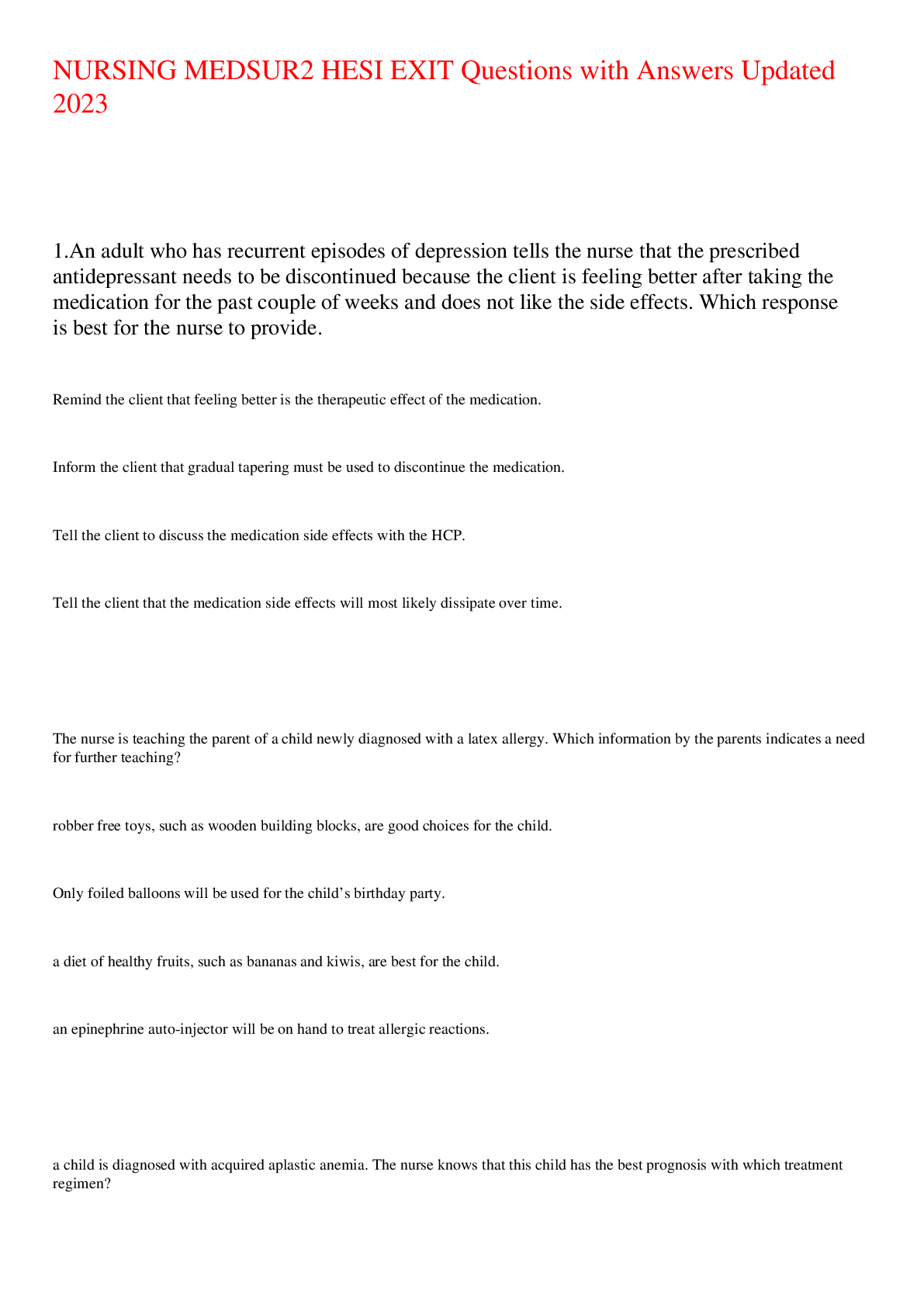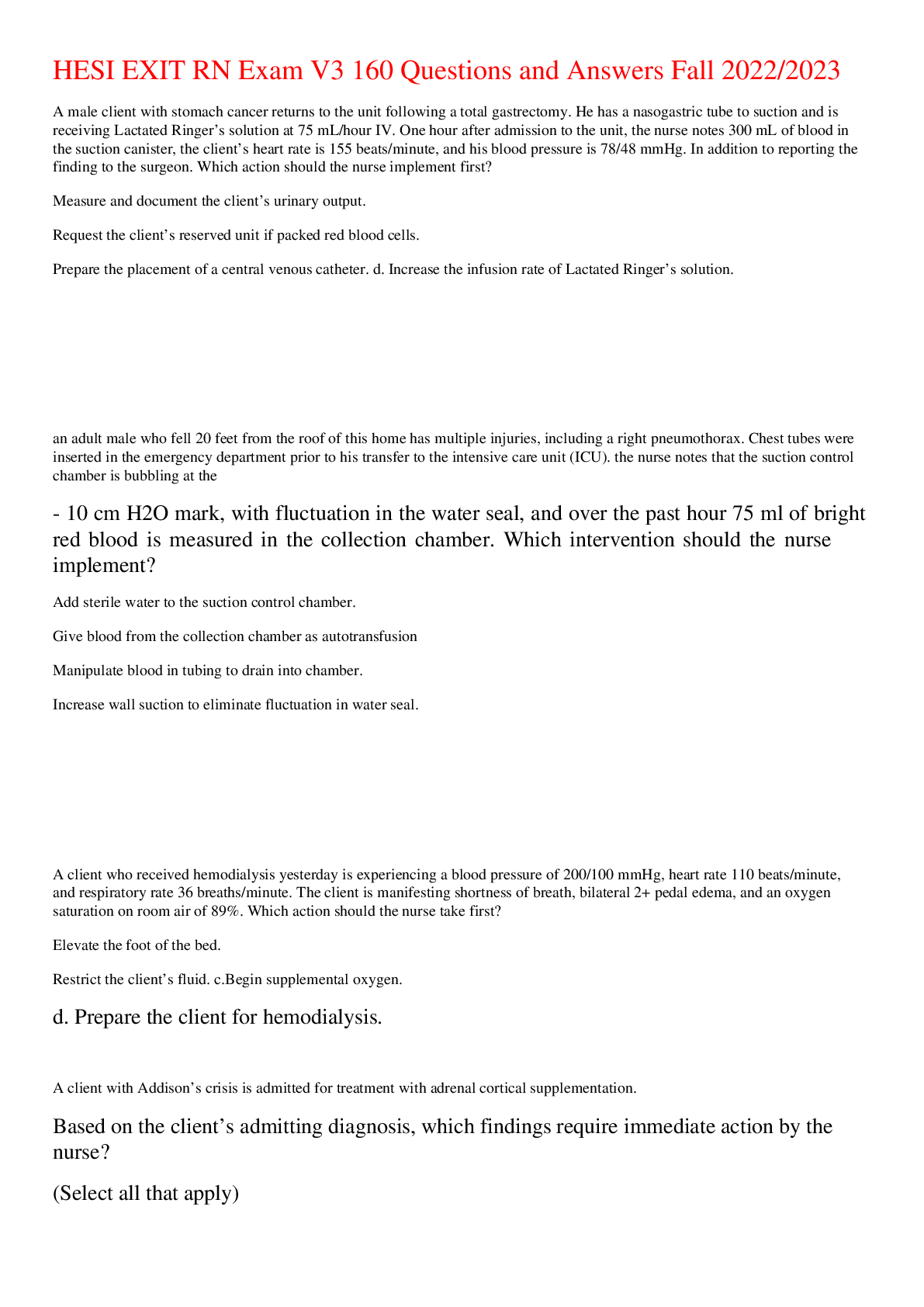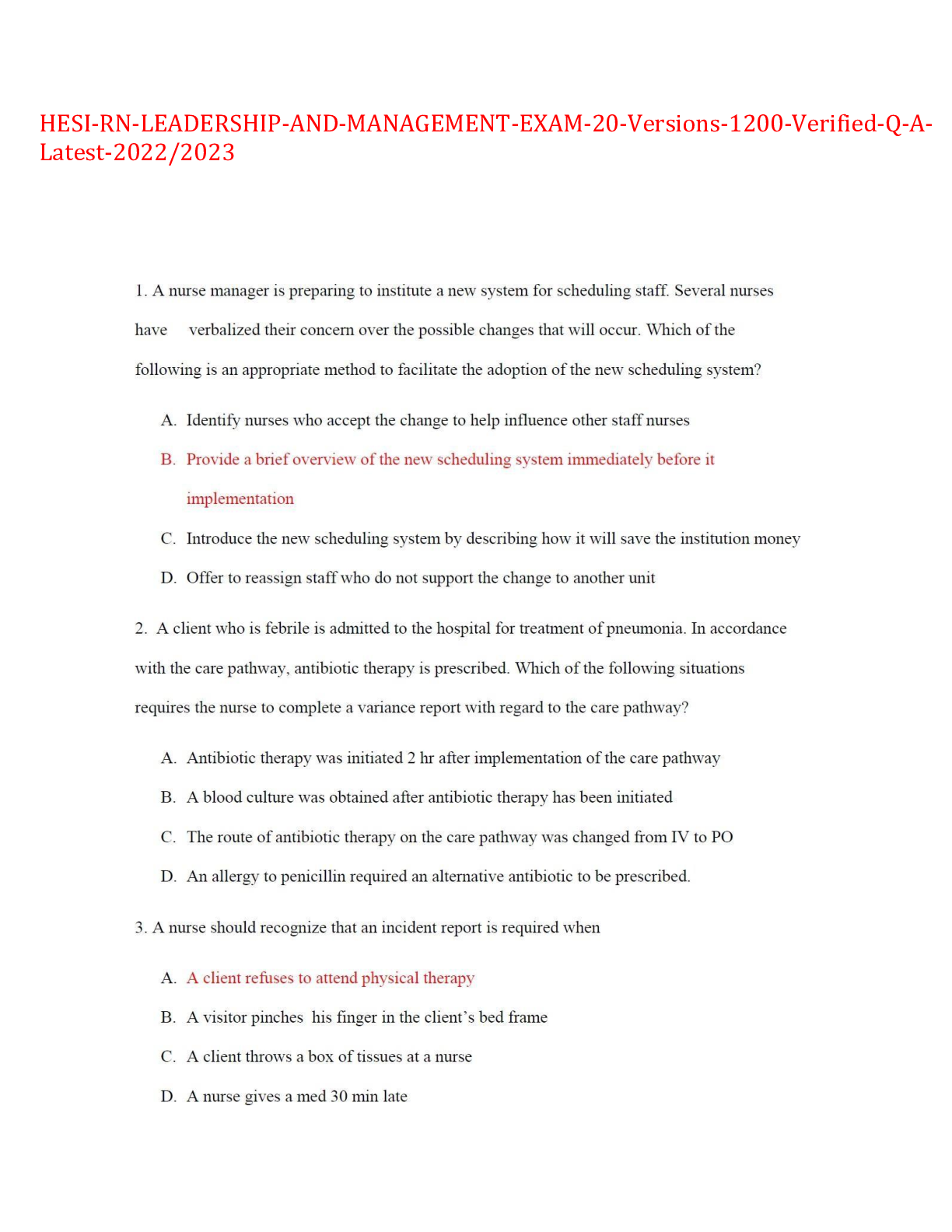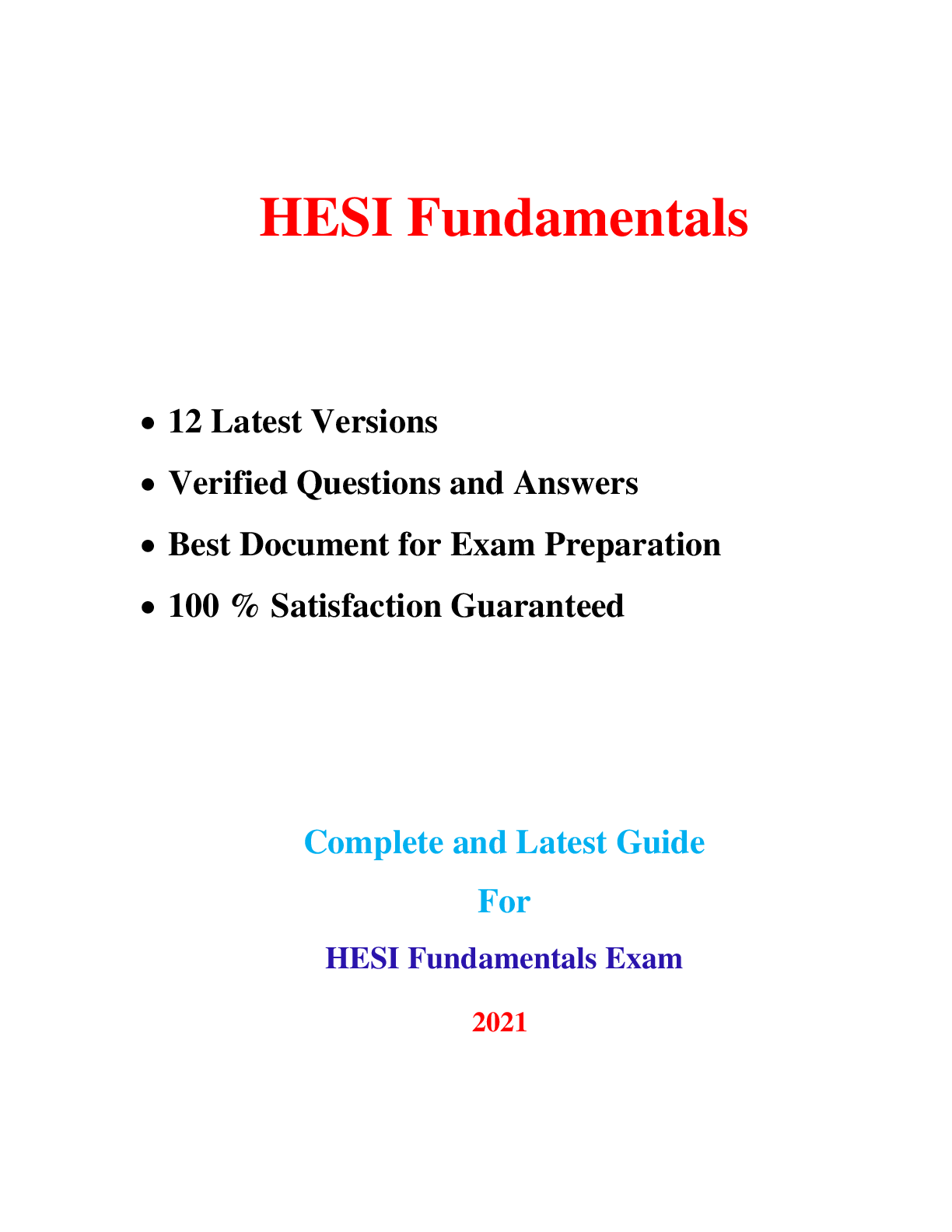NURS FUNDAMENTAL HESI EXIT key points 2021/2022,100% CORRECT
Document Content and Description Below
NURS FUNDAMENTAL HESI EXIT key points 2021/2022 Fluid & electrolytes and Acid Base balance. Anasarca: generalized edema Fluid-related problems: Infants and older adults are at higher risk • ... Children have a greater proportion of body water • Older adults have the least proportion of body water. Infants and older adults need to be monitored closely for fluid imbalances. Insensible loss: water lost through the skin and expired air in lungs. The client with diarrhea is at high risk for a fluid and electrolyte imbalance. Hypertonic dehydration: cells shrink Excessive perspiration, hyperventilation, ketoacidosis, pronged fevers Hypotonic dehydration: cells swell (water is retained) • Chronic illness, excessive fluid replacement • Kidney disease, chronic malnutriotn. Extracellular: just means outside cells; like in vascular or interstitial A client with acute kidney injury or chronic kidney disease is at high risk for fluid volume excess. Common food sources with Potassium • Avocado • Bananas • Cantaloupe • Oranges • Strawberries • Tomatoes • Carrots, mushrooms, spinach, • Fish, pork, beef, veal • Potatoes • Raisins. Potassium loss causes • Overuse of Diuretics and corticosteroids • Cushing’s syndrome- increased secretion of aldosterone (Salty aldo) • Vomiting, diarrhea • Wound drainage- particularly GI • Prolonged nasogastric suction • Excess sweating • Kidney disease impairing reabsorption of potassium • Hyperinsulinism Oral potassium: may cause N/V and should be taken with food to decrease GI upset Liquid Potassium: taste horrible and should be taken with juice or other liquid. IV potassium: never administered by IV push, intramuscular or subQ routes. IV potassium is always diluted and administered using an infusion device! Potassium retaining may be caused by • Adrenal insufficiency—Addison’s disease • Potassium-retaining diuretics • Kidney disease--- can do hypo or hyper!! • Salt substitutes Prepare for the IV administration of hypertonic glucose with regular insulin to move excess potassium into the cells. If potassium is critically high, prepare client for dialysis Lithium toxicity: hyponatremia (low sodium <135) precipitates lithium toxicity in a client taking lithium. Sodium and potassium are inversely related: Na↓=K↑ Hypernatremia (↑Na+) causes • Cushing’s syndrome • Corticosteroids • Kidney disease • HyperAldo Hypocalcemia: Positive traousseau’s and Chvostek’s sign • Chvostek’s--- cheek • Trousseau’s sign—carpal spasm induced by inflating a blood pressure cuff. • Hyperactive deep tendon reflexes • Tetany • Painful muscle spasms in the calf or foot during periods of rest Hypercalcemia • Increased bone resorption due to malignancy (bone destruction from metastatic tumors) A client with a calcium imbalance is at risk for a pathologic fracture. Move the client carefully and slowly; assist the client with ambulation. Magnesium and Calcium are best friend. If one goes up the other follows. If one goes down the other follows. Hypomagnesum • May be caused by chronic alcoholism • Malabsorption (celiac disease, crohns disease, malnutrition and starvation) Hypermagnesium • Can be caused by renal insufficiency • Diminished deep tendon reflexes • Weak skeletal muscle. Calcium gluconate is the antidote for magnesium overdose Magnesium Sulfate (MGSO4) Toxicity- BURP • BP Decreased↓ • Urinary output Decreased↓ • Respiratory rate Decreased↓ • Patellar reflex absent Phosphorus and Calcium have a reciprocal (inverse) relationship Phosphate binding medication---hyperphosphatemia • Increase fecal exertion of phosphorus by binding phosphorus from food in the GI tract • Avoid laxatives and enemas when taken binders. • Take with meals or immediately after meals Carbon Dioxide (CO2): Acid • Lungs excrete volatile hydrogen in the form of CO2 Bicarbonates (HCO3): Base Acidosis: respiratory rate and depth increase in an attempt to exhale acids (rapid and deep) • Like in DKA- Kussmals respiration are compensating for Acid buildup • K+ levels increase--- body protects itself by moving H+ into cells, thus kicking K+ out of cell. Alkalosis: respiratory rate and depth decrease; CO2 is retained to componsate and decrease the strength of excess bicarbonate. • K+ levels decrease- body releases H+ ion into blood forcing K+ into cells. Hypoventilation: retains CO2 leading to resp acidosis. Hyperventilation: rapidly blowing off CO2 leading to resp. Alkalosis Clients with a history of emphysema or COPD usually are not given oxygen greater than 2 liters by cannula since high levels of oxygen in the blood can decrease the stimulus to breathe leading to CO2 retention and respiratory acidosis. If more oxygen is required a Venturi mask will be the appropriate mask. Nasal Cannula: only goes up to 6. If the client has a condition that causes OVERSTIMULATION of the respiratory system, monitor the client for respiratory Alkalosis. • Fever, hyperventilation, Pain • Hysteria • Overventilation by mechanical ventilators An insufficient supply of insulin in a client with diabetes mellitus can result in metabolic acidosis known as DKA • Insulin opens the cells for glucose and K+ to go in. Causes for Metabolic Acidosis • DM • Excessive ingestion of acetylsalicylic acid (Aspirin) • High-fat diet--- break down of fat creates Ketones (Acidic) • Insufficient metabolism of carbohydrates • Renal insufficiency, acute kidney injury or chronic kidney disease--- increased waste buildup • Diarrhea. Arterial blood gases (ABGs) • Perform the Allen’s test to determine the presence of collateral circulation prior to obtaining an arterial blood specimen. Allen’s Test • Apply pressure over the ulnar and radial arteries simultaneously. • Ask client to open & close hand repeatedly • Release pressure from the Ulnar and assess color Apply pressure to puncture site following the blood draw; maintain pressure for 5-10 min in the client is taking an anticoagulant. [Show More]
Last updated: 2 years ago
Preview 1 out of 8 pages

Buy this document to get the full access instantly
Instant Download Access after purchase
Buy NowInstant download
We Accept:

Reviews( 0 )
$15.00
Can't find what you want? Try our AI powered Search
Document information
Connected school, study & course
About the document
Uploaded On
Jun 06, 2022
Number of pages
8
Written in
Additional information
This document has been written for:
Uploaded
Jun 06, 2022
Downloads
0
Views
73











